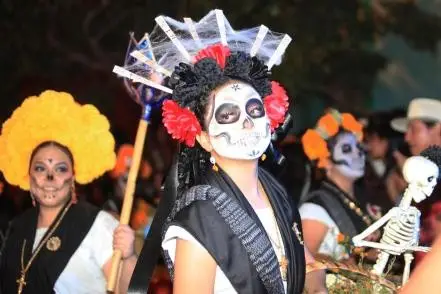
Dozens of packages that include “facial characterization” with figures such as skulls and catrinas, tours of cemeteries and samples of Zapotec cuisine are advertised on social networks to learn about the “Day of the Dead celebration” in the city of Oaxaca.
The tours, also advertised in English, are offered at prices per person ranging from 800 to 2 thousand pesos. Travel agencies have been receiving reservations since the beginning of October.
In Oaxaca, gentrification has reached local celebrations. Cemeteries packed with tourists following guides, who offer explanations in English, at the San Miguel Cemetery, the Atzompa Cemetery and the death camps of the Eteco Valley are common in the first days of November, while local families visit the graves of those who are no longer here.
On October 27, 9 months have passed since the arrest of the people who participated in the march against gentrification in January, in the midst of the most acute water and garbage crisis that the Oaxacan capital and the municipalities surrounding it have experienced in recent years.
In an interview, Filx Aldaz, an activist who supports the community soup kitchen that provides food to migrants and one of the people arrested after the protest against cultural appropriation, points out that institutions support the actions that gentrification in Oaxaca is not only experienced through the displacement of the inhabitants of the downtown area, but also through language killing and the arrival of mega projects that exploit state lands.
“Urban centers are conditioned by whitewashing, cultural appropriation. What I have always insisted on is languagecide. For me, gentrification is not only the arrival of people to do tourism, but it is also dispossession, but first and foremost it is languagecide: the displacement of a local language,” he says.
Filx is an Ajuuk speaker, and he maintains that these are the original languages and their variants that were displaced first through Castilianization, imposing Spanish as the hegemonic language and displacing the original languages, as if they had no value outside the contexts of the communities.
Geographer Luis Alberto Salinas Arreortúa, researcher at the Institute of Geography (IGg) of the UNAM, explains that “gentrification is a process of restructuring social relations in space. It refers to the fact that different sectors of the population with greater economic capacity appropriate urban spaces that present certain qualities, for example green areas, good location, equipment, infrastructure and cultural areas that are highly sought after by real estate capital.”
For Filx, the phenomenon has older and deeper roots. And in recent times, they are reflected in the displacement of Spanish by English, derived from the excessive flow of foreign tourists.
“Getting to know other territories is a right, but in Oaxaca, English is being imposed over Spanish, not only as a culture or with the rise in prices, but also economically, since local people no longer have a place for racialized people, who are criminalized for their skin color, eyes, anatomy or tattoos,” he points out.
Phrases in Ayuujk were tattooed on Filx’s face to make her language visible; however, this has earned her a criminalization by the government of Salomón Jara and his officials, after her arrest for protesting against gentrification on January 27.
The same thing happens, she points out, with activists and defenders. And she mentions the case of Sandra Domínguez, originally from the Mixe region of San Isidro Huayápam, since October 4. Sandra, she recalls, denounced the coordinator of peace delegates of the local government, Donato Vargas, for exercising digital violence against Mixe women, in a chat.
“There is no culture in the villages… they are criminalized”
In light of this, Filx maintains that it is not an isolated event, since it is the state that criminalizes and marginalizes those who denounce them. “The sale of tourism and culture is something promoted by the government. In the towns and communities, the culture that is sold on tourist tours does not exist,” he reiterates.
He also points out that at the beginning of the current administration, Triqui protesters who were holding a protest outside the Government Palace were violently evicted.
“We left our communities, not by choice, however, we are criminalized… when we try to go out into the streets to demand our rights, we are not heard, on the contrary, we are persecuted and imprisoned,” he insists.
Nine months after the protest against gentrification, “they offer us handouts and crumbs,” as well as appointments to address the psycho-emotional and physical consequences left by the arbitrary detention, he comments.
Those who have joined in the discontent over gentrification on different media channels agree with Filx that Oaxaca, through the government, is sold and folklorized for tourism. The opposite happens, he says, with the migrant population, which is singled out, violated and extorted by the authorities, mainly by the police.
Meanwhile, the Oaxaca Tourism Secretariat (Sectur) estimates that the Oaxacan capital will register a hotel occupancy of 78.7% during these holidays, the arrival of more than 72 thousand national and international tourists, as well as an economic spillover of approximately 289 million pesos.
Likewise, the agency reported that on the dates indicated, the state of Oaxaca will receive 194 flights from six national destinations as well as from international destinations such as Los Angeles, Houston, Dallas, Calgary, Vancouver and Edmonton.
To this, Aldaz adds, is added the arrival of mining companies and megaprojects, in order to exploit the local workforce, as well as to exploit the land for centuries, causing effects on health, mainly in the child population, as a consequence of extractivism, which also makes life more expensive, not only in the capital, but also in the communities. “They are shooting us in our own territories,” he concludes.
Source: oaxaca.eluniversal






